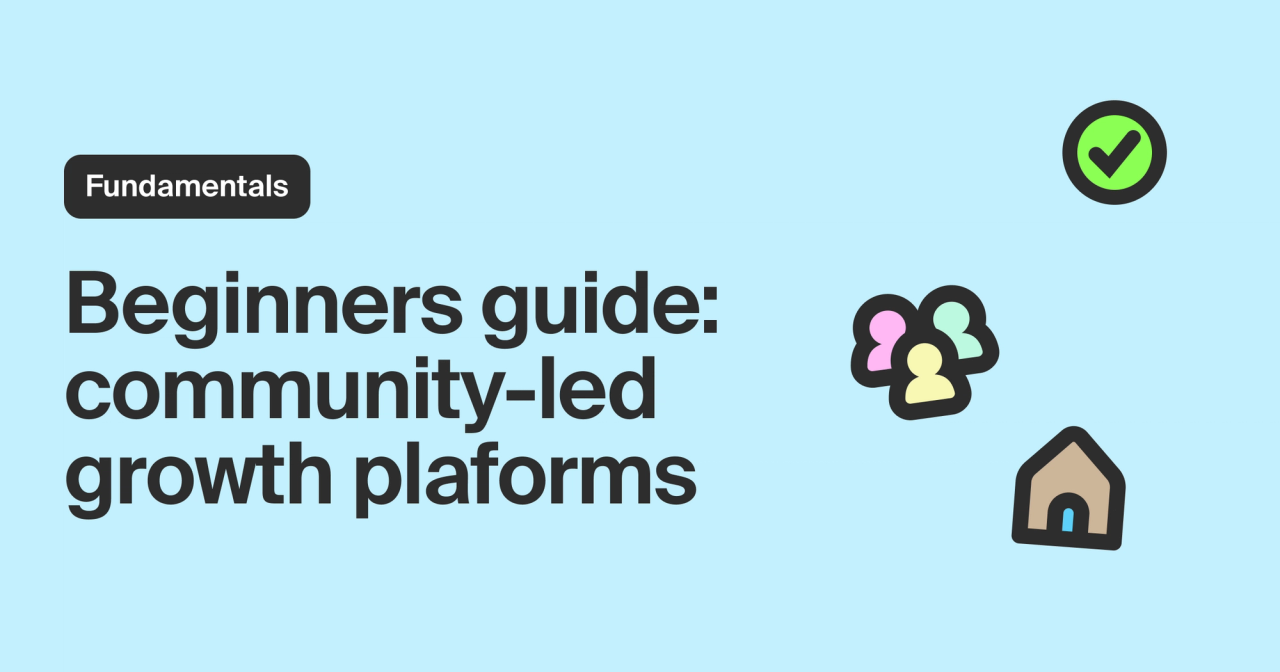Community-led growth, a business strategy for driving customer acquisition and retention through community-building initiatives, has emerged as a critical element of many companies’ go-to-market plans.
Savvy adopters of this strategy often look for a tool to accelerate their efforts and allow the company—and its community—to realize the benefits of community-led growth (CLG) more quickly and at a greater scale. After all, high-growth companies are always looking for ways to grow more efficiently.
Enter: The community-led growth platform. In the same way that a carpenter can get more work done with a drill than a screwdriver, companies toiling away to manually extract community data and insights from various sources stand to benefit greatly from using an intelligent community-led growth platform.
Take a look below to learn more about what defines a community-led growth platform, associated benefits, and best practices for getting started with this impactful tool.
What is a community-led growth platform?
A community-led growth platform is a technology that brings together community engagement, product usage, and customer data into a single place. This helps companies deepen relationships within their communities, build better products based on feedback, and connect the dots between community activity and key business results.
A community-led growth platform should have the following features:
- A unified view of each member, across every channel: Brings together information from community sources to create a 360 degree view of each member and their activity.
- Intelligence to surface insights and trends: Offers a way to understand essential community health indicators—what people are saying, how they're feeling, and how they're engaging.
- Recommended actions to engage your community: Enables taking action, like automating a welcome message or an alert on any negative sentiment for a new product in the market.
- Reporting to demonstrate the impact of community: Provides visibility into community growth and the impact of CLG on the business.
An intelligent community-led growth platform like Common Room takes this a step further by using artificial intelligence (AI) and natural language processing (NLP) to automatically surface insights from connected data sources and empower users to act on that information. This allows community-led growth teams to discover what’s most important in their communities, nurture key personas, measure program impact, and collaborate across the business.
What are the benefits of a community-led growth platform?
Investing in a community-led growth platform provides several key advantages across different parts of the business. Some of the top benefits of a community-led growth platform include:
- Community managers can keep members engaged and happy without increasing the workload of the community team.
- Valuable community insights and trends can easily be identified, collected, and shared with the appropriate stakeholders.
- The business impact of community can be quantified, which means community-attributed revenue has quickly become a reality.
- GTM teams can more fully understand the user journey by tying product, customer, and community data together.
The reality is that every company—including yours—has an existing community that can be used to market, sell, and fuel growth loops across the business. If you don’t acknowledge your community and proactively work to activate the power of your champions, you may be letting detractors influence the perception of your company for those that are just getting introduced.
A community-led growth platform makes it easier than ever to build transformative customer relationships and turn community into your most powerful growth engine. Whether you’re looking to gather actionable insights, recognize patterns, measure community outcomes across multiple channels, or all of the above, it is the all-in-one solution for unlocking the full potential of community-led growth.
Increasingly, both community leaders and executives want to be able to measure the ROI of their community investments. This is extremely challenging—if not impossible—without a community-led growth platform. However, with such a solution, companies are able to prove the business value of community. That’s exactly what Asana did when they started using Common Room to measure and increase the impact of their program.
Getting started with a community-led growth platform
Once you have decided to try a community-led growth platform, there are a few initial steps you should take to lay the foundation for future success.
Determine where you lie on the community maturity curve
Before setting near- and long-term goals, it’s important to pinpoint where your organization currently lies on the community maturity curve in order to level-set expectations and chart a sustainable growth path.
This maturity curve can be broken down into three distinct phases:
- Phase 1: Seeding your community. Here the focus is on picking one or two community channels to launch, such as a messaging app, then aiming to steadily increase membership and activity within your community.
- Phase 2: Facilitating growth and sustained engagement. During this phase, you will look to expand into a few additional channels, such as a forum, knowledge base, and/or customer success tool. This will help increase the number of ways users can interact with your company and each other, plus it will help you identify more active members to participate in the community.
- Phase 3: Showing community impact on the business. This phase is where the promise of community-led growth is truly realized, as you will begin to integrate customer data (e.g., HubSpot) and product usage alongside your other community data sources. You will use this 360 degree view of your members to report on direct attribution of community activity against key business goals, such as product adoption and annual recurring revenue.
Identify your KPIs and North Star metrics
The next step in getting started with a community-led growth platform is to identify a few key metrics to track against over a given business quarter or year, depending on where you are on the community maturity curve.
If you are primarily focused on seeding, growing, and sustaining your community (Phases 1-2), you will typically select a few community growth KPIs—also called community health KPIs—to measure against. These key performance indicators can be monitored to ensure your community is growing at the desired rate and that members feel satisfied as they continue to receive value from the group:
- Total membership
- Overall engagement rate
- # of active members
- Average member sentiment
- Top membership by geography
- Response rate
- Most active members
For example, Asana chose to measure community growth metrics like the total number of members joining their Ambassador program and the number of community-related event signups to ensure their program is appropriately engaging their members.
Once your company has reached a high level of maturity and is ready to prove bottom-line impact by tying community to attribution, retention, and business growth (Phase 3), you will expand to measure community-led growth KPIs—also called business KPIs. You’ll bring a community lens to evaluating GTM metrics like:
- Deal pipeline
- Annual recurring revenue
- Customer acquisition cost
- Customer lifetime value
- Customer retention rate
- Product usage / adoption
- Support efficacy
For example, Asana looks at business metrics like event-driven product adoption and community-attributed revenue to measure the success of their community-led growth efforts. In fact, many companies have realized that community drives business results faster than other GTM strategies. One Common Room customer found that 72% of community-led deals close within 90 days vs. only 42% of sales- and marketing-led deals.
Integrate data sources into your community-led growth platform
Your community-led growth efforts are only as strong as the data you are able to leverage and integrate. Ideally, you will want to incorporate a wide range of data sources across communication apps, social media channels, forums, event platforms, customer success tools, and more. As your program maturity allows, you should also enrich this information with product and revenue data.
A community-led growth platform makes this step a breeze by providing out-of-the-box integrations for all of the community, product, and customer data sources you care about most. It’s also recommended that you choose a platform with an accessible API so you can capture community activity data from any source and tie it to specific members and organizations.
Measure performance and adjust goals over time
Once you have integrated your community data sources and are officially up and running with your community-led growth platform, you should create and share reports on community growth and impact at your preferred cadence (weekly, monthly, quarterly, etc.).
Having a consistent reporting schedule will help your community team and the broader business adjust month-over-month and quarter-over-quarter goals as baseline metrics are set and new KPIs are potentially added into the mix (or misleading/irrelevant KPIs are scrapped).
Using a community-led growth platform allows you to monitor and adjust community metrics more quickly to match the priorities and growth of your community and business. For example, Asana uses Common Room to automate their reporting process, grow the impact of current programs, and democratize vital community data internally.
“Common Room empowers us to take action in a very direct way that clearly ladders up to the success of our business and, most importantly, the success of Asana’s customers.”
– Joshua Zerkel, Head of Global Engagement Marketing at Asana
Common Room: The leading intelligent community-led growth platform
If you’re looking to get started with an intelligent community-led growth platform so you can tie community activity to key business outcomes, look no further than Common Room.
From delivering high-value insights powered by machine learning to providing the tools required to use community to improve prospecting, lead qualification, and pipeline velocity, Common Room has everything needed to turn your community into an incredibly effective growth lever. Take a look at some of the cutting-edge features we’ve added in just the last few months.
We are rolling out new features regularly and our solution’s ability to prove valuable correlations between community engagement and key business results will only continue to get more sophisticated.
To intelligently engage and grow your community, try Common Room for free or request a demo.
Looking for more info on building a community-led growth strategy? Check out our post on best practices for community-led growth and connect with 1000+ community and DevRel leaders to share expertise and ask questions in the Uncommon community.

